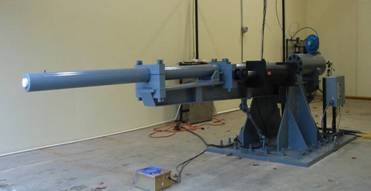
Combustion light gas gun
Encyclopedia
Combustion light gas gun technology is one of the areas being explored in an attempt to achieve higher velocities from artillery to gain greater range. Conventional guns use solid propellants, usually nitrocellulose-based compounds to develop the chamber pressures needed to accelerate the projectiles. The propellant is ignited; burns, expands, and propels the projectile out of the barrel. A combustion light gas gun (CLGG) uses low molecular weight gas, such as hydrogen mixed with oxygen, as propellant. The gases are ignited, burn, expand and propel the projectile out of the barrel with higher efficiency relative to solid propellant and have achieved higher muzzle velocities in experiments.
Further Information
CLGG’s gaseous propellants are able to increase the propellant's specific impulse
. Therefore, hydrogen is typically the first choice; however, other propellants like methane can be used.
Utron is experimenting with a potentially weaponizable CLGG. Utron Inc. claims to have a system ready in the near term for testing as a potential long-range naval fire support weapon for emerging ships like the Zumwalt-class destroyer (DD(x) or DDG-1000). The CLGG is a possible candidate technology for greater ranges for naval systems, among others. Utron Inc. has built and tested a 45 mm CLGG and a 155 mm CLGG. Videos of the 155 mm CLGG can be seen at www.utroninc.com http://www.utroninc.com.
While this technology does appear to provide higher velocities, the main drawback with gaseous or liquid propellants for gun systems is the difficulty in getting uniform and predictable ignition and muzzle velocities. Variance with muzzle velocities affects precision in range and the further a weapon shoots, the more significant these variances become. If an artillery system can't maintain uniform and predictable muzzle velocities it will be of no use at the longer ranges.
Another issue is the survival of projectile payloads at higher accelerations. Fuses, explosive fill, and guidance systems all must be "hardened" against the significant acceleration loads of conventional artillery to survive and function properly. Higher velocity weapons, like the CLGG, face these engineering challenges as they edge the boundaries of firing velocities higher.
Paul Darst of the State Journal wrote the article “Cutting Edge, High Velocity” on Thursday, February 15, 2007 about the combustion light gas gun..
http://www.statejournal.com/story.cfm?func=viewstory&storyid=20077&catid=165


Further Information
CLGG’s gaseous propellants are able to increase the propellant's specific impulse
Specific impulse
Specific impulse is a way to describe the efficiency of rocket and jet engines. It represents the derivative of the impulse with respect to amount of propellant used, i.e., the thrust divided by the amount of propellant used per unit time. If the "amount" of propellant is given in terms of mass ,...
. Therefore, hydrogen is typically the first choice; however, other propellants like methane can be used.
Utron is experimenting with a potentially weaponizable CLGG. Utron Inc. claims to have a system ready in the near term for testing as a potential long-range naval fire support weapon for emerging ships like the Zumwalt-class destroyer (DD(x) or DDG-1000). The CLGG is a possible candidate technology for greater ranges for naval systems, among others. Utron Inc. has built and tested a 45 mm CLGG and a 155 mm CLGG. Videos of the 155 mm CLGG can be seen at www.utroninc.com http://www.utroninc.com.
While this technology does appear to provide higher velocities, the main drawback with gaseous or liquid propellants for gun systems is the difficulty in getting uniform and predictable ignition and muzzle velocities. Variance with muzzle velocities affects precision in range and the further a weapon shoots, the more significant these variances become. If an artillery system can't maintain uniform and predictable muzzle velocities it will be of no use at the longer ranges.
Another issue is the survival of projectile payloads at higher accelerations. Fuses, explosive fill, and guidance systems all must be "hardened" against the significant acceleration loads of conventional artillery to survive and function properly. Higher velocity weapons, like the CLGG, face these engineering challenges as they edge the boundaries of firing velocities higher.
Paul Darst of the State Journal wrote the article “Cutting Edge, High Velocity” on Thursday, February 15, 2007 about the combustion light gas gun..
http://www.statejournal.com/story.cfm?func=viewstory&storyid=20077&catid=165



